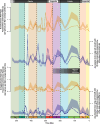Record of Foraminifera test composition throughout the Phanerozoic
- PMID: 40202068
- PMCID: PMC11979970
- DOI: 10.1098/rspb.2025.0221
Record of Foraminifera test composition throughout the Phanerozoic
Abstract
Marine calcifiers produce calcareous structures (e.g. shells, skeletons or tests) and are therefore sensitive to ocean chemistry. Nevertheless, the long-term evolutionary consequences of marine carbonate changes are not well understood. This article compares calcareous and non-calcareous responses to ocean chemistry changes throughout the Phanerozoic Eon (541 million years ago to present). To accomplish this, we calculated proportional wall-type diversity, origination rates and extinction rates for 2282 benthic foraminiferal genera. Calcareous origination and extinction rates fluctuated throughout the Palaeozoic Era (541-251.9 million years ago), but during the Mesozoic Era (251.9-66 million years ago), calcareous origination and extinction rates stabilized following the evolution of pelagic calcifiers. Despite variations in Cenozoic Era (66-0 million years ago) foraminifera diversity, calcareous wall types maintained around 77% proportional diversity. Although calcareous wall-type extinction rates decline during the Mesozoic and Cenozoic, Phanerozoic foraminifera wall-type changes during individual events are largely contingent upon contemporaneous conditions rather than overarching trends. Of the Big Five mass extinction events, calcareous wall-type proportions only decreased at the end-Permian (73% to 26% diversity) and end-Triassic (56% to 50% diversity). These results suggest long-term ocean chemistry changes were not the main driver of foraminiferal wall-type diversity through time.
Keywords: Foraminifera; Phanerozoic; benthic; calcium carbonate; marine ecosystems.
Conflict of interest statement
We declare we have no competing interests.
Figures





Similar articles
-
Oceanographic controls on the diversity and extinction of planktonic foraminifera.Nature. 2013 Jan 17;493(7432):398-401. doi: 10.1038/nature11815. Epub 2013 Jan 9. Nature. 2013. PMID: 23302802
-
Renewal of planktonic foraminifera diversity after the Cretaceous Paleogene mass extinction by benthic colonizers.Nat Commun. 2022 Nov 21;13(1):7135. doi: 10.1038/s41467-022-34794-5. Nat Commun. 2022. PMID: 36414628 Free PMC article.
-
Post-extinction recovery of the Phanerozoic oceans and biodiversity hotspots.Nature. 2022 Jul;607(7919):507-511. doi: 10.1038/s41586-022-04932-6. Epub 2022 Jul 13. Nature. 2022. PMID: 35831505 Free PMC article.
-
Permian-Triassic Osteichthyes (bony fishes): diversity dynamics and body size evolution.Biol Rev Camb Philos Soc. 2016 Feb;91(1):106-47. doi: 10.1111/brv.12161. Epub 2014 Nov 27. Biol Rev Camb Philos Soc. 2016. PMID: 25431138 Review.
-
The geological record of ocean acidification.Science. 2012 Mar 2;335(6072):1058-63. doi: 10.1126/science.1208277. Science. 2012. PMID: 22383840 Review.
References
-
- Knoll AH. 2003. Biomineralization and evolutionary history. Rev. Mineral. Geochem. 54, 329–356. (10.2113/0540329) - DOI
-
- Intergovernmental Panel On Climate Change (IPCC) . 2023. Climate change 2021—the physical science basis: Working Group I contribution to the sixth assessment report of the Intergovernmental Panel on Climate Change, 1st edn. Cambridge, UK: Cambridge University Press. (10.1017/9781009157896) - DOI
-
- Ridgwell A. 2005. A mid Mesozoic revolution in the regulation of ocean chemistry. Mar. Geol. 217, 339–357. (10.1016/j.margeo.2004.10.036) - DOI
MeSH terms
Grants and funding
LinkOut - more resources
Full Text Sources

